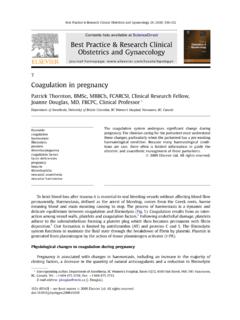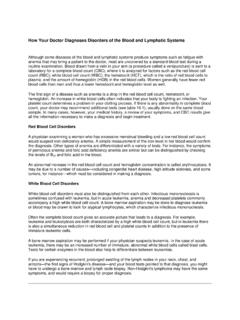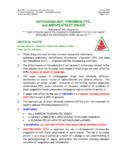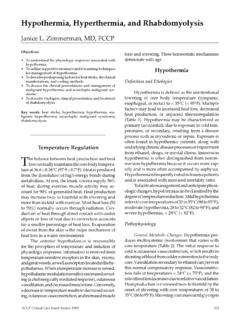Transcription of A Heads Up on Subgaleal Hemorrhage - Houston …
1 A Heads Up on SubgalealHemorrhageCheryl McDuffie MSN, FNP-C, RNC-NICD isclosures I have nothing to discloseObjectives After this presentation the learners will be able to:oDifferentiate between common scalp swellings and Subgaleal hemorrhageoIdentify delivery history and physical assessment findings which warrant frequent reassessment for signs of Subgaleal hemorrhageThe Case This is a published case presentation. Any resemblance to a case in any local hospital is purely coincidental. All pictures are publicly available on the internet. All patient pictures are from published articles in reference of Baby JaneAssessment 41 week, 3891Gm female Gravida-1 Para-0 Spontaneous labor Vacuum extraction vaginal delivery Tight nuchal cord cut approximately 50 seconds prior to delivery Mild shoulder dystocia Apgars 3 @ 1, 4 @ 5, and 7 @ 10 3/deck/6048127 Scalp swellings Scalp swellings Caput succedaneumoSerosanguineous fluid in subcutaneous tissues of presenting partoSoft spongy, crosses suture lines, shifts with positioningoMinimal blood lossoResolves in 48-72 hoursCaput succedaneumScalp swellings CephalohematomaoBlood accumulation between skull bone and periosteumoDoes not cross suture lines, initially firmoLocation- parietal and occipital bones, 85% unilateraloBlood loss is rarely severeoResolves in 2 weeks to 3 swellings Subgaleal hemorrhageoRupture of the emissary veins, blood accumulation in the subaponeurotic blood loss possible.
2 No barrier to stop the can hold 240ml Newborn blood volume 78-86ml/Kg (Harriet Lane, 2012) 3Kg infant, 80ml/Kg = 240mloSpace extends from nape of neck to orbits of the eyes and from ear to see fluid waveoDisplace ear anteriorlyoSwelling around the eyesoResolves in 2-3 weeks High 27 12 3pm scalp cranial cavity/deck/4588068 Subgaleal diary/makehtml/division/thrathip/ I think about CephalohematomaSubgaleal hemorrhageIncidence 1 in 2500 spontaneous vaginal births 10 fold increase with the use of forceps or vacuum Vacuum use is reported in approximately 49% of all Subgaleal Hemorrhage (Schierholz, E., Walker, , 2010)Vacuum Assisted Assisted Delivery System is secure and gentle 20004131 factors associated with SGH after vacuum assisted delivery Nulliparous mother Failed vacuum extraction Inadvertent cup release (pop-offs) Sequential use of vacuum and forceps Apgar less than 8 @ 5 min following vacuum assisted delivery Deflexing cup application (cup edge less than 3 cm from anterior fontanel) Paramedian cup application (cup centered more than 1 cm lateral to sagittal suture)(Karlsen, 2013) (suppl1)/ do we place on all newborns?
3 Case of Baby JaneAssessment 41 week, 3891Gm female Gravida-1 Para-0 Spontaneous labor Vacuum extraction vaginal delivery Tight nuchal cord cut approximately 50 seconds prior to delivery Mild shoulder distocia Apgars 3 @ 1, 4 @ 5, and 7 @ 10 minutesWhat else would you like to know? Question 1 Question 2 Question 3 How long? How long was the vacuum in place prior to delivery?oTime from initiation of vacuum to delivery 21 minutesHow many? How many pop-offs?o multiple pop-offs Where was the cup placed? Where is the chignon (cup mark)?oUnknownCase of Baby JaneAssessment 41 week, 3891Gm female Gravida-1 Para-0 Spontaneous labor Vacuum extraction vaginal delivery Tight nuchal cord cut approximately 50 seconds prior to delivery Mild shoulder distocia Apgars 3 @ 1, 4 @ 5, and 7 @ 10 minutesCase of Baby Jane Baby required bag mask ventilation for ~ 4 minutes On examination bogginess of scalp noted Baby described as flaccid and shocked looking To nursery for observation hrs of life transport called because baby paler and unresponsiveCase of Baby Jane Fluid boluses suggested but no IV access Transport noted severe swelling of the baby s scalp Hct @ hrs of life 34 compared to cord Hct 49 Rec d 50ml/Kg crystalloid and blood plus glucose, NaHCO3, DopamineCase of Baby Jane Despite NICU care baby continued to deteriorate with severe encephalopathy, profound hypotension, renal failure, disseminated intravascular coagulation (DIC), she died at 18 hours of life.
4 Postmortem exam confirmed massive Subgaleal Hemorrhage , with several diastatic fractures and anoxic- ischemic changes within the Get complete delivery history Number of pop-offs, length of time with suction Assess location of suction mark Initial Head circumference Reassessment of FOC- each cm increase in FOC = approximately 40ml of blood loss (Reid, 2007) Assess for signs of shock- increased HR, decreased BP, increased cap refill, pallor Plan Diagnostic testing Blood gas, Hct, clotting studies, Blood products- Hypovolemic shock Blood volume replacement (FFP, PRBC) Platelets and clotting factors (DIC) Inotropes to maintain adequate blood pressureImplementationNursing care Assess and stabilize respiratory status Assess head and skull for abrasions, ecchymosis, and swelling Measure head circumference Obtain laboratory studies: blood gas, type and cross, CBC, coagulation studies Obtain IV access; peripheral vs umbilical Communicate with family, transport team, and physiciansEvaluation Continued frequent assessment of vital signs, respiratory status, head examination and laboratory studiesDid I meet the objectives?
5 After this presentation the learners will be able to:oDifferentiate between common scalp swellings and Subgaleal hemorrhageoIdentify delivery history and physical assessment findings which warrant frequent reassessment for signs of Subgaleal hemorrhageReferences Chang, H., Peng, C., Kao, H., Hsu, C., Hung, H., Chang, J. Neonatal Subgaleal Hemorrhage : Clinical presentation, treatment, and predictors of poor prognosis. Pediatrics International. 49. 903-907. Davis, D. J. (2001) Neonatal Subgaleal Hemorrhage : diagnosis and management. Canadian Medical Association Journal. 164(10). 1452-1453. Federal Drug Administration (1998) FDA public health advisory: Need for caution when using vacuum assisted delivery devices. Retrieved on July 8, 2013 from Karlsen, K, (2013) The STABLE Program Learner Manual. Inc. Salt Lake City, UT. O Grady, (2012) Vacuum extraction. Medscape. Retrieved September 18, 2013 from Reid, J. (2007) Neonatal Subgaleal Hemorrhage .
6 Neonatal Network. 26(4). 219-227. Schierholz, E., Walker, (2010) Responding to traumatic birth Subgaleal Hemorrhage , assessment and management during transport. Advances in Neonatal Care. 10(6). 311-315. Tscudy, , Arcara, (2012) The Harriet Lane Handbook. 19thedition. Elsevier Philadelphia, PA. Wetzel, , Kingman, (2012) Subgaleal Hemorrhage in a neonate with factor X deficiency following a non-traumatic cesarean section. Journal of Perinatology. 32. 304-305.









